How to Remove Sweat Stains From Pillow Cases
You can effectively remove sweat stains from pillowcases using common household items and proper techniques. Start by pre-treating the stains with a paste made from equal parts baking soda and water, letting it sit for 30 minutes. For stubborn stains, try soaking the pillowcase in a mixture of white vinegar and water (1:3 ratio) for 15 minutes before washing. Machine wash using the highest temperature suitable for the fabric type, adding ½ cup of white vinegar to the rinse cycle. Air-dry in direct sunlight for natural sanitization and enhanced stain removal. Proper maintenance and prevention strategies can help you maintain pristine pillowcases long-term.
This post may contain affiliate links. If you make a purchase through these links, I may earn a commission at no additional cost to you. Additionally, portions of this post may be generated using artificial intelligence (AI) technology. While we strive for accuracy, please be aware that AI-generated content may not always be perfect and should be fact-checked when necessary.
The Spatula Scoops
- Create a paste with baking soda and water, apply to stains for 30 minutes, then wash normally in the hottest water safe for fabric.
- Soak pillowcases in a mixture of white vinegar and water (1:3 ratio) for 15 minutes before washing to remove stains and odors.
- Pre-treat stubborn stains by blotting with hydrogen peroxide, letting it sit for one hour before laundering in warm water.
- Wash pillowcases weekly using the highest recommended temperature, adding 1/2 cup of vinegar to the rinse cycle.
- Air-dry pillowcases in direct sunlight after washing, as natural UV rays help sanitize and further remove stubborn stains.
Understanding Pillowcase Sweat Stains

Anyone who's ever noticed yellow stains on their pillowcase knows how unsightly and frustrating they can be. These sweat stains aren't just about appearance – they're actually a combination of your body's natural perspiration, body oils, and salt deposits that accumulate over time. When you sleep, your pillowcase absorbs these substances, leading to gradual discoloration that's particularly noticeable on light-colored fabrics.
You'll find that keeping your pillowcases clean isn't just about aesthetics. The buildup of sweat and oils can create an environment where bacteria thrive, potentially causing skin irritations or breakouts. To prevent sweat stains and maintain healthy skin, you'll need to understand what causes these marks in the first place. Environmental factors like room temperature and humidity play significant roles, as do your choice of bedding materials. Synthetic fabrics often trap moisture more than natural fibers, making stains more likely to develop. When you're ready to remove stains, you'll want to use appropriate cleaning agents that can break down both the protein and mineral components of sweat without damaging the fabric's fibers.
Pre-Treatment Methods That Work

When treating sweat stains on your pillowcases, you'll want to start with gentle blotting using a clean cloth, followed by applying natural remedies like a baking soda paste or eco-friendly stain removers. Before applying any treatment to the entire stain, you should always perform a spot test on a hidden area of the fabric to guarantee the solution won't cause discoloration or damage. For the most effective results, let your chosen pre-treatment solution sit on the affected area for 5-10 minutes, giving it time to break down the sweat residue before proceeding with your regular wash cycle.
Natural Stain Treatment Options
Looking for a chemical-free way to tackle those pesky sweat stains on your pillowcases? Several natural stain treatment options can effectively remove sweat stains while being gentle on your bedding and the environment.
Start by gently blotting any fresh sweat stains with a clean cloth to absorb excess moisture. For a powerful natural solution, create a paste using equal parts baking soda and water. Apply this mixture directly to the stained areas of your pillowcases and let it sit for 30 minutes before laundering. This method helps lift both stains and odors effectively.
Another proven approach involves soaking your pillowcases in a solution of white vinegar and water before washing. The acidic properties of vinegar break down stubborn sweat residue while naturally deodorizing the fabric. For particularly tough stains, try combining lemon juice and salt to create a natural scrub. Apply it with a nylon brush using gentle, circular motions. You can also enhance your regular detergent mixtures by adding a small amount of vinegar or baking soda to boost their stain-fighting power. Remember to treat stains as soon as possible for the best results.
Spot Testing Safety First
Safety stands at the forefront of any stain treatment process. Before you tackle those unsightly sweat marks on your pillowcase, it's vital to conduct a proper spot-test with your chosen stain remover. Select an inconspicuous corner or seam of your pillowcase, apply a small amount of the product, and wait 5-10 minutes to confirm there's no adverse reaction to the fabric's color or texture.
Once you've confirmed the stain remover is safe, you'll want to proceed with a gentle blot technique using a clean cloth. Whether you're using eco-friendly solutions or traditional cleaners, always work from the outside of the stain toward the center to prevent spreading. Don't rush this process – let the cleaner sit for the recommended time, usually 3-5 minutes, before moving forward.
Before laundering, thoroughly rinse the treated area with cold water. This important step removes any remaining cleaning agents that could potentially set the stain during washing. If you're using natural solutions like baking soda paste, be equally cautious with the spot-testing process, as even natural remedies can affect different fabric types differently.
Quick Blotting Techniques
Throughout the stain removal process, quick and effective blotting serves as your first line of defense against stubborn sweat marks. When you notice yellow or gray discoloration on your pillowcase, grab a clean cloth or paper towel immediately to begin the quick blotting process, which helps absorb moisture before it sets deeper into the fabric.
To enhance effectiveness, press the cloth firmly against the stain without rubbing, as this prevents the sweat from spreading to unaffected areas. Once you've absorbed the initial moisture, prepare a mild detergent solution or apply your preferred stain remover directly to the spot. Let the cleaning solution sit for 3-5 minutes as part of your pre-treatment routine, allowing it to break down the sweat residue effectively.
For particularly stubborn stains, you'll want to incorporate natural solutions into your approach. Add a tablespoon of baking soda to your detergent mixture, or create a diluted white vinegar solution to help neutralize both the stain and any accompanying odors. Remember to maintain gentle pressure throughout the blotting process, ensuring you're lifting the stain rather than forcing it deeper into the fabric.
Natural Stain Removal Solutions
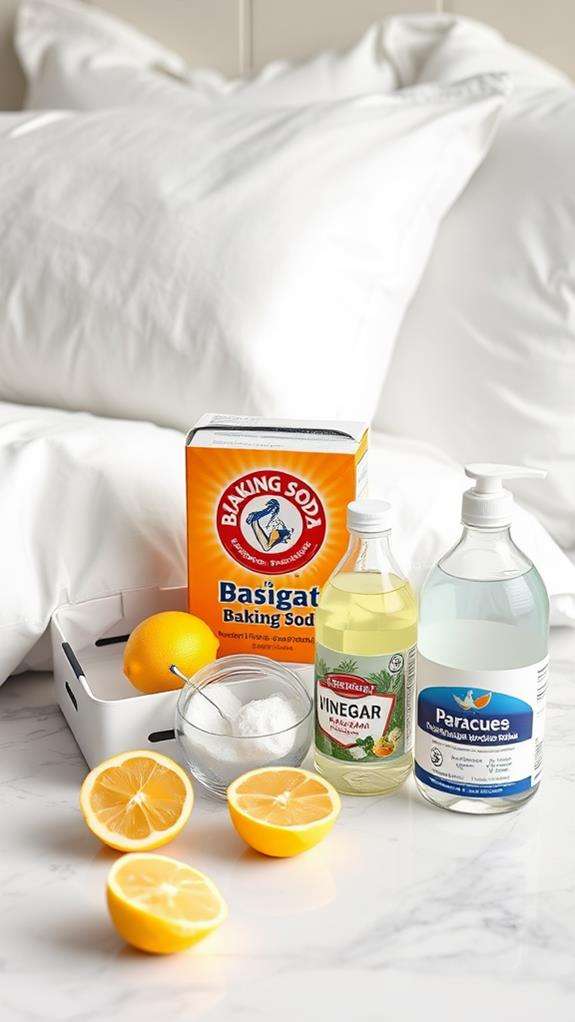
Several natural solutions from your kitchen cabinet can effectively tackle those stubborn sweat stains on your pillowcases. You'll find that ingredients like baking soda, white vinegar, and lemon juice work exceptionally well at breaking down oils and residue that cause discoloration.
| Natural Solution | Application Method |
|---|---|
| Baking Soda | Mix equal parts with water, apply paste for 30 minutes |
| White Vinegar | 1:3 ratio with water, soak for 15 minutes |
| Lemon Juice | Combine with salt, scrub gently for 30 minutes |
| Hydrogen Peroxide | Apply directly, let sit for one hour |
| Vinegar Rinse | Add ½-1 cup to washing machine's rinse cycle |
When using these natural stain removal methods, you'll want to be consistent with the application times to achieve the best results. Create a baking soda paste and apply it directly to the stained areas, letting it work its magic for half an hour. For particularly stubborn stains, try soaking your pillowcases in the white vinegar solution before proceeding with your regular wash cycle. Remember to always test these solutions on a small, inconspicuous area first to verify they won't damage your fabric.
Machine Washing Best Practices
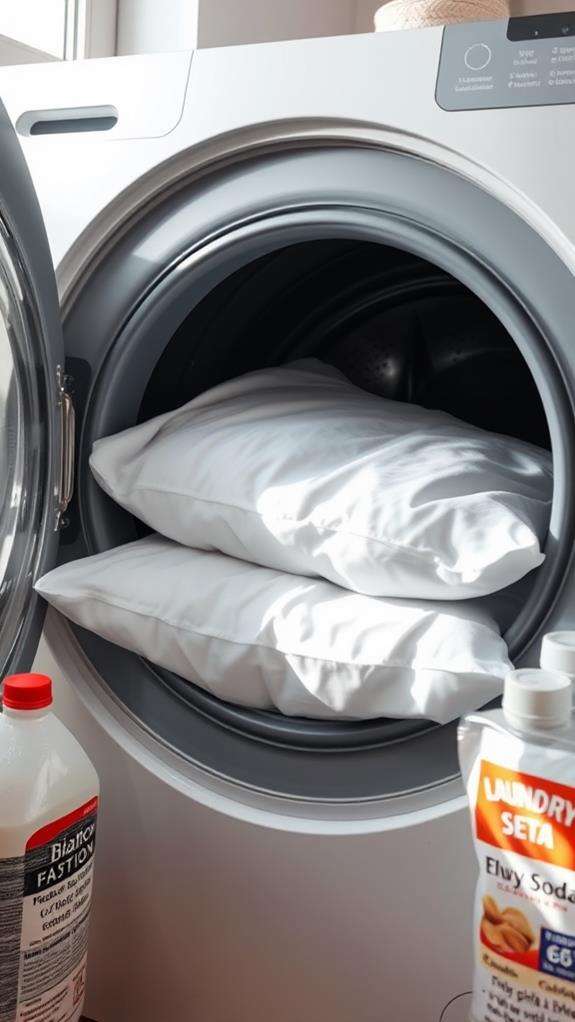
Proper machine washing techniques can make all the difference when tackling sweat-stained pillowcases. Before you wash pillowcases, always check the care label to determine the appropriate water temperature and cycle settings for your specific fabric type. For cotton pillowcases, use the highest allowable temperature to effectively remove sweat stains, while delicate materials like silk require gentler cycles and cooler water.
To maximize your machine washing results, start by pre-treating stubborn stains before loading your pillowcases into the washer. Add your regular mild detergent, and consider incorporating half a cup of white vinegar to the wash cycle. The vinegar works alongside your detergent to break down perspiration marks and eliminate lingering odors. When selecting your wash cycle, make sure you're using enough water to allow the pillowcases to move freely in the machine.
Once the wash cycle is complete, resist the urge to use your dryer. Instead, air dry your pillowcases, preferably in direct sunlight when possible. This natural drying method helps prevent stains from becoming permanently set in the fabric and extends the life of your pillowcases.
Fabric-Specific Cleaning Techniques
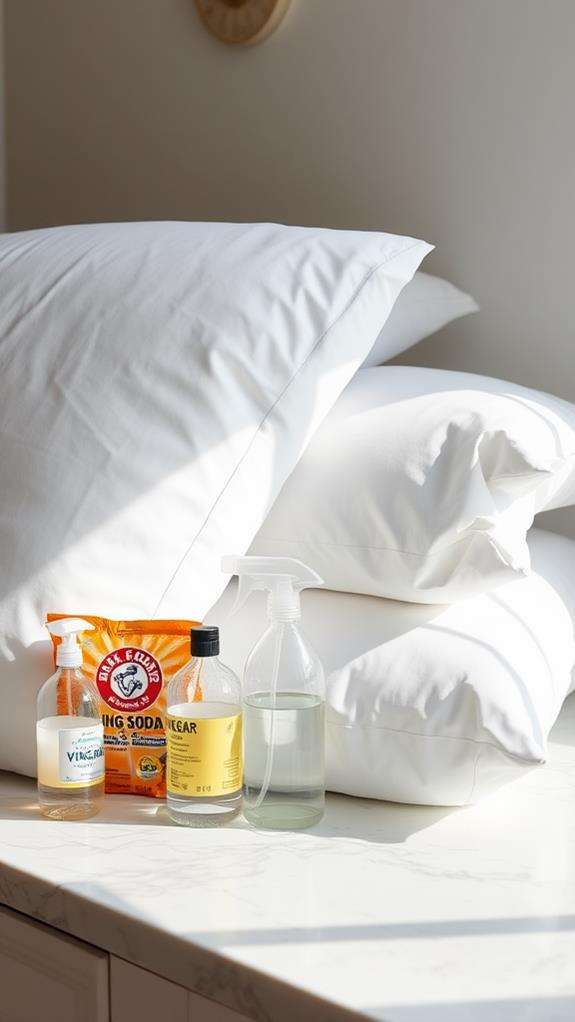
When treating cotton and silk pillowcases, you'll need to use distinctly different cleaning methods to protect each fabric's unique properties. For cotton pillowcases, you can safely use oxygen-based bleach or hydrogen peroxide after spot-testing, while silk requires a much gentler approach with a mild detergent diluted in cool water. You'll find the best results by always checking the care label first and using the appropriate water temperature for your specific fabric type, as hot water can set stains permanently in certain materials.
Cotton and Linen Care
Different fabrics demand specific cleaning approaches, and cotton and linen pillowcases are no exception. For cotton pillowcases, you'll want to tackle those stubborn sweat stains with a simple yet effective method. Create a paste using baking soda and water, apply it directly to the stained areas, and let it sit for 30 minutes before washing. You can also use an oxygen-based bleach or hydrogen peroxide solution, but remember to spot-test first to avoid any unwanted discoloration.
When it comes to linen pillowcases, you'll need to take a gentler approach. Always wash them in cool or lukewarm water with a mild detergent, as hot water can weaken the fibers over time. For those pesky sweat stains on linen, pre-soak your pillowcases in a mixture of white vinegar and water before washing. This combination effectively breaks down both stains and odors without damaging the delicate fabric. Whatever fabric you're dealing with, it's essential to follow the care instructions on your pillowcases' labels. Pay particular attention to recommended wash cycles, as different fabrics require varying levels of agitation to maintain their quality and appearance.
Silk Treatment Methods
Treating silk pillowcases requires special care to maintain their luxurious feel and appearance. When you're dealing with sweat stains on silk, it's important to use cleaning methods that won't damage the delicate fabric. Before you begin any treatment, test your cleaning solution on a hidden area to prevent potential damage or discoloration.
To clean pillowcases made of silk, you'll need a gentle laundry detergent specifically designed for delicate fabrics. Create a mixture of white vinegar and cool water, then gently blot the sweat stains with a soft cloth. Never use harsh chemicals or bleach, as they'll compromise the silk's integrity and natural sheen. Once cleaned, air dry your pillowcases away from direct sunlight to preserve their quality.
| Step | Action | Important Note |
|---|---|---|
| 1 | Spot test | Use hidden area first |
| 2 | Mix solution | Equal parts vinegar/water |
| 3 | Treatment | Gentle blotting only |
Remember to handle your silk pillowcases with extra care during the cleaning process. Don't wring or twist the fabric, as this can damage the fibers. Instead, press gently with a clean, dry towel to remove excess moisture before hanging to air dry.
Prevention Tips for Better Sleep
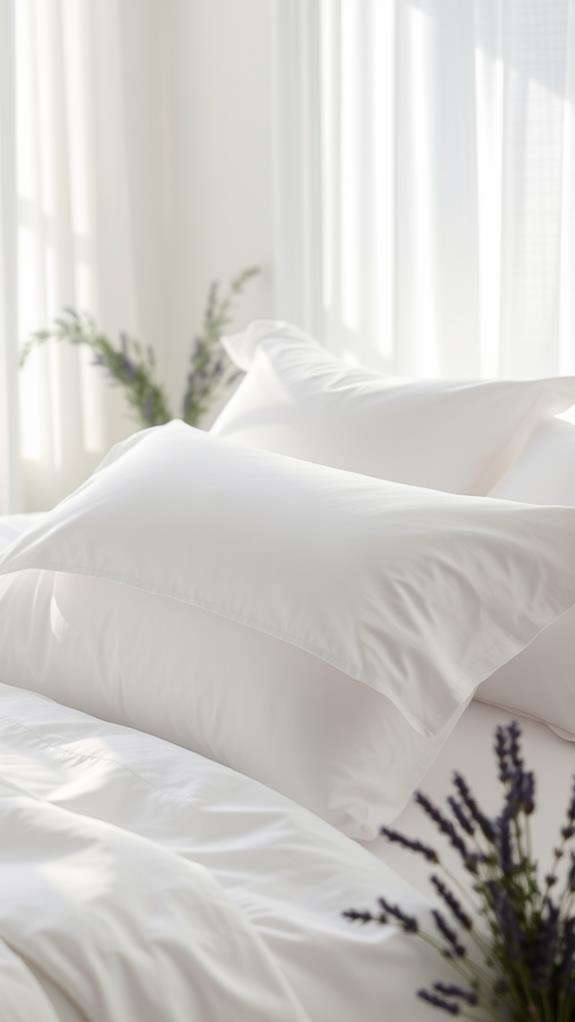
A few simple preventive measures can help you maintain cleaner pillowcases while improving your sleep quality. Start by setting your air conditioning or thermostat between 60-67°F (15-19°C), as this temperature range helps prevent excessive sweating during sleep. You'll notice fewer sweat stains on your pillowcases when you maintain this ideal sleeping environment.
Choose pillowcases made from breathable materials like cotton or bamboo, which effectively wick away moisture and allow proper air circulation throughout the night. Before heading to bed, make it a habit to shower, removing the day's accumulated oils and sweat that could transfer to your bedding. When applying your nighttime skincare products, opt for lightweight, non-comedogenic formulas that won't leave heavy residue on your pillowcases.
For an extra layer of protection, invest in quality pillow protectors that create a barrier between your face and the pillowcase. These washable covers help prevent stains from reaching your pillowcases while extending their lifespan. By implementing these preventive strategies, you'll maintain cleaner pillowcases longer and create a more hygienic sleeping environment that promotes better rest.
Daily Maintenance and Care
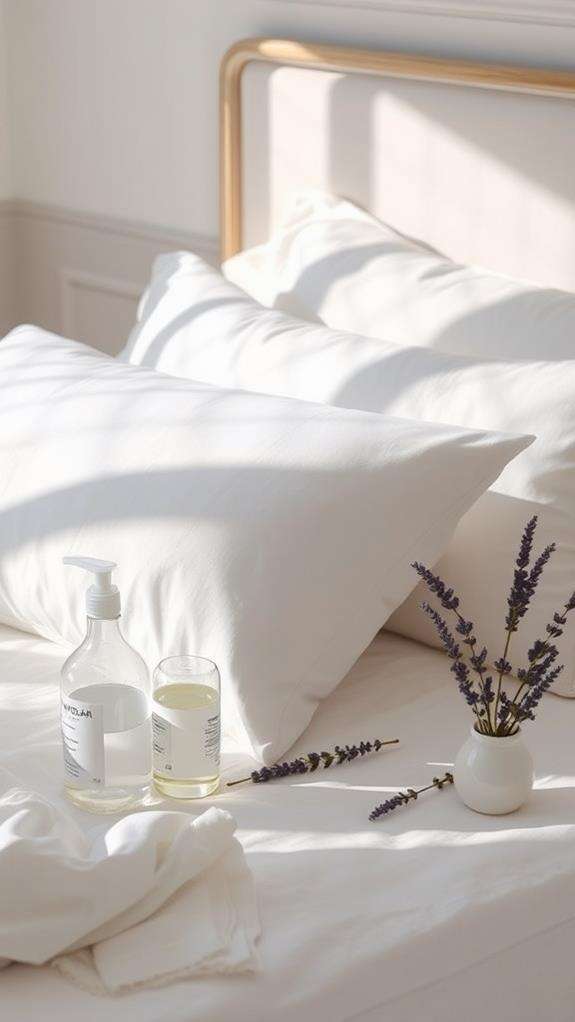
Through consistent daily care, you'll greatly reduce the appearance and formation of sweat stains on your pillowcases. To maintain ideal cleanliness and protect your skin and hair, you'll need to regularly change and wash your pillowcases at least once weekly. When you notice stains developing, don't wait to address them – prompt attention is vital for effective stain removal.
To remove existing sweat stains, create a simple paste using baking soda and water, applying it directly to the affected areas before laundering. After washing, air-dry your pillowcases whenever possible, as this method helps prevent stains from setting and maintains fabric integrity. To keep your pillowcases in the best condition, choose breathable materials like cotton or bamboo, which naturally regulate moisture and temperature while you sleep. Additionally, maintaining a cool bedroom environment with proper ventilation will considerably reduce sweating during sleep. Remember to rotate your pillowcases regularly, keeping several sets on hand so you can easily swap them out when needed. This systematic approach to pillowcase maintenance won't just extend their lifespan – it'll also provide a cleaner, more hygienic sleeping environment.
Deep Cleaning Methods
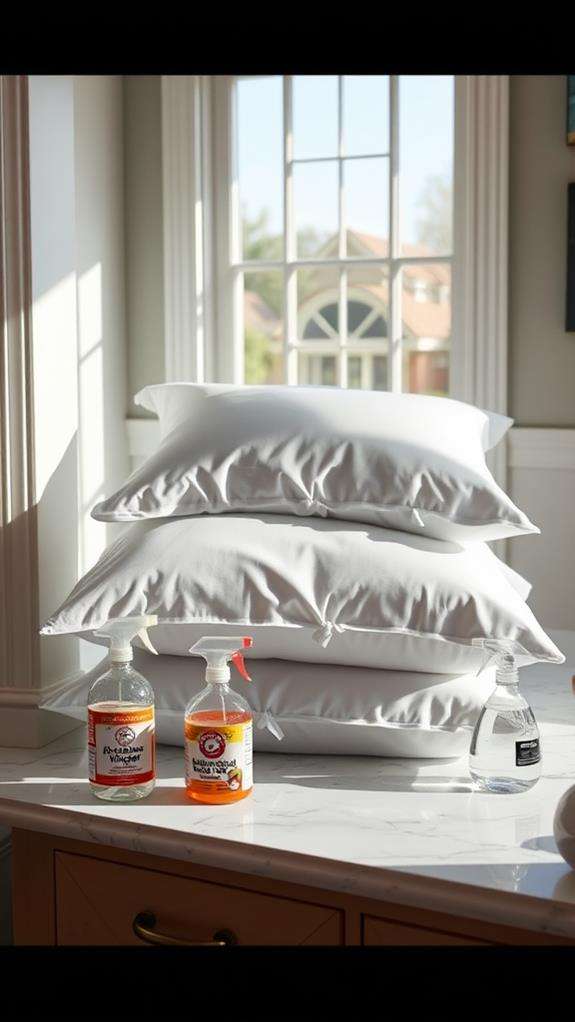
Effective deep cleaning can rescue even the most severely stained pillowcases. To remove stubborn stains on pillowcases, you'll want to start with an overnight soak in a solution of warm water mixed with oxygen bleach. This powerful combination helps break down even the most set-in sweat marks, preparing them for a thorough wash.
- Soak your pillowcases overnight in the cleaning solution, ensuring they're fully submerged
- Use a soft-bristled brush to gently work the solution into particularly tough stains
- Add white vinegar to your wash cycle for enhanced stain removal and odor elimination
When you're ready for washing pillowcases, select the hottest water temperature that's safe for your fabric type. Add 1/2 to 1 cup of white vinegar during the wash cycle for extra deep cleaning power. For particularly stubborn stains, you might need to repeat the process, but don't rush to put them in the dryer. Instead, take advantage of nature's whitening power by hanging them outside. The sun's UV rays will continue working on any remaining discoloration while naturally disinfecting your pillowcases, leaving them fresh and bright.
Common Household Cleaning Solutions

Many powerful stain-fighting solutions are already sitting in your kitchen cabinets, ready to tackle those stubborn sweat marks on pillowcases. You'll find that baking soda, a natural deodorizer, can be mixed with water to create an effective paste that breaks down sweat stains when left on the fabric for 30 minutes before washing.
White vinegar proves especially useful when you're dealing with both stains and odors. You can add it directly to your laundry detergent, or pre-soak your pillowcases in a vinegar solution before washing. For tough stains, try creating a mixture of liquid dish soap and water, applying it directly to the affected areas and letting it sit for half an hour to lift body oils and perspiration marks.
If you're looking for a natural scrubbing solution, combine lemon juice with salt and work it into the stained areas. Let this mixture sit for 15 to 30 minutes before rinsing. This method not only helps remove sweat stains but also helps eliminate dust mites and other allergens that might be lurking in your pillowcases, making them both clean and hygienic.
Frequently Asked Questions
How to Get Sweat Stains Out of Pillowcase?
You'll want to tackle those sweat stains quickly using a few effective methods. For fresh stains, blot the moisture and apply a baking soda paste, letting it sit for 15-30 minutes. If you're dealing with set-in stains, soak your pillowcase in a vinegar-water solution for 30 minutes before washing. You can also try mixing hydrogen peroxide with liquid dish soap, applying it directly to the stain. Always wash in cool water to prevent setting.
How Do You Get Yellow Stains Out of Pillowcases?
Just like lifting clouds from a sunny sky, you'll make those yellow stains vanish by following these proven methods. Create a paste using baking soda and water, apply it directly to the stains, and let it sit for 30 minutes. You can also soak your pillowcases in a vinegar-water solution for 15-30 minutes before washing. For stubborn stains, try combining hydrogen peroxide with mild dish soap, then wash in hot water.
How to Remove Sweat Smell From Pillowcases?
You'll effectively remove sweat smells from pillowcases by adding 1/2 cup of white vinegar during the rinse cycle. For stubborn odors, sprinkle baking soda directly on damp pillowcases before washing, or soak them in warm water with baking soda for 30 minutes. Using an odor-eliminating detergent will boost your results. Don't forget to air-dry your pillowcases in sunlight when possible, as this naturally kills odor-causing bacteria.
How Do You Get Greasy Head Stains Out of Pillowcases?
To remove greasy head stains from your pillowcases, you've got several effective options. Start by applying a mixture of dish soap and warm water, letting it sit for 30 minutes. For stubborn stains, create a baking soda paste and leave it overnight. You can also try spraying white vinegar directly on the stains, waiting 15-30 minutes before washing. For tough cases, use an aspirin solution by soaking the stained area overnight.





